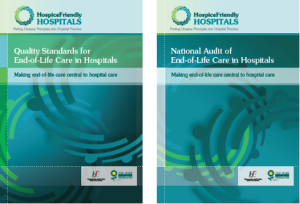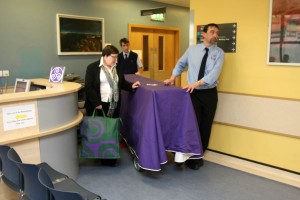
Imagine a project which seeks to take the best attributes of hospice care and inculcate them into the fabric of the acute hospital. Not just one hospital, but all hospitals in a whole country. Consider a project that is about a joined up approach to clinical care when death is near, that takes seriously the relationship between hospital design and the potential to deliver dignified care, and that adopts an ‘all systems’ approach to its mode of operation. Think of a project that has been able to attract support from major celebrities, politicians and people from the creative media to promote better end of life care in hospitals and advocate for change. These are just some of the ingredients of the Hospice Friendly Hospitals initiative that first began to develop in Ireland in the late 1990s.
This week the Irish Hospice Foundation – the home and source of inspiration for the idea of Hospice Friendly Hospitals – is publishing two reports on this work, and taking stock of where it can go in the future. One of the reports was prepared by Fiona Graham and I – and takes the form of a narrative history of the entire Hospice Friendly Hospitals initiative over a period of almost 15 years – from initial ideas, to pilot scheme, to national roll out. The report turns a detailed gaze on the intervention, suggests ideas for future consideration and may also inspire others to adopt and adapt the ‘Hospice Friendly’ concept elsewhere.
What are Hospice Friendly Hospitals?
Hospice Friendly Hospitals (HFH) is a multi-centre intervention to develop end of life care capacity, advocate for patients and families and create systems level change in the delivery of hospital care at the end of life in Ireland. Its work and the ideas that contribute to it have been developed and supported by the Irish Hospice Foundation (IHF) and it has occupied a key place within IHF strategy since 2004, when a pilot scheme was initiated. The HFH programme specifically was a five-year work-stream (2007-2012) designed to improve the quality of end-of life care in acute and community hospitals in Ireland. Initiated by the IHF in partnership with the Health Service Executive (HSE) and with a major grant from The Atlantic Philanthropies, as well as the support of the Dormant Accounts Fund and the Health Services National Partnership Forum, the programme had three goals:
• To develop comprehensive standards for all hospitals in relation to dying, death and bereavement
• To develop the capacity of acute and community hospitals to introduce and sustain these standards
• To change the overall culture in hospitals and care settings in relation to dying, death and bereavement
Aims and design of the narrative history
We had three goals for our study of Hospice Friendly Hospitals, which was commissioned by the IHF:
1) To construct a narrative history of HFH – from its earliest origins and covering its first five years (2007-12) of national roll out.
2) To answer key questions about its content, modes of operation, impacts and efficacy as a source of advocacy for end of life care in hospitals
3) To draw conclusions to influence its future development and sustainability in Ireland, as well as its possible applicability in other jurisdictions.
We made use of a range of methods for this work: analysis of programme documents, reports, minutes of meetings, media outputs, promotional and educational materials; qualitative interviews with HFH staff and stakeholders; field and ethnographic observations based on attendance at meetings, conferences and other key events. Our goal was to develop a wide-ranging analysis of HFH and at the same time to ‘tell a story’ about its development.
Key achievements of the HFH programme
In the years 2007-12 the HFH programme consisted of four main components: 1) Design and dignity/the physical environment 2) Communication/competence and compassion 3) Integrated care/planning and co-ordination 4) Patient autonomy/an ethical approach.
HFH also developed a comprehensive set of National Quality Standards for End-of-life Care in Hospitals and sought to underpin these with a National Audit System to provide a base-line of end of life care in hospital settings and to assist in evaluating the quality of hospital end of life care over time. The baseline audit of end of life care in Irish hospitals included 999 patient cases and was conducted in 2008-9, leading to a follow up that was piloted in late 2012.
Undoubtedly HFH raised the profile of end of life care in hospitals through the four components of the programme, in the production of a set of recognised standards and in the conduct of the national audit. It also made significant headway with its Final Journeys training programme for healthcare staff, the creation of an Ethical Framework for end of life care, the development of material resources for use at ward level (see picture below), the conduct of a Practice Development initiative for end of life care and in the establishment of a Network of Hospice Friendly Hospitals and of Community Hospitals. Within individual participating hospitals, end of life care became included in service and development plans, standing committees for end of life care were established, senior managers became engaged in relevant issues and staff members were released for training of various kinds. Across all its activities the HFH programme supported hospital staff in a non-judgmental and practical way.
In total 32 out of 57 acute public hospitals engaged with the HFH programme in some way in the period 2007-12. Among the 147 community hospitals in Ireland, some 50 became involved in the HFH Community Hospitals Network.
Analysis
Our study set out to answer the following questions:
1. How did the HFH programme come about, what factors shaped its initial development and how consequential were these for the programme over time?
Hospice Friendly Hospitals had a gradual gestation, starting in the mid-1990s, when trustees of the Irish Hospice Foundation began to take an interest in how hospice principles could be fostered in the practice and organisation of acute hospitals. It was able to attract significant philanthropic funding and also led to a partnership arrangement with the Health Service Executive (HSE). The HFH programme has been widely praised for the inventiveness, richness and imaginative qualities of its various components. Sponsorship by IHF, philanthropic funding at a high level and partnership with a newly formed HSE were critical to the origins of HFH and also shaped its evolution. The programme was given considerable scope by IHF to act independently in the early years, but subsequently was folded back into IHF strategy. The partnership with HSE had some success at the operational level, but struggled to gain traction in ways that could influence wider priorities, policies and programmes within the health system.
2. What are the key factors and content of programme development and delivery, how did these change over time and with what consequences?
Over time HFH developed into a rich and varied tapestry of resources, interventions and strategies. It also sought to forge a culture of optimism that change could be achieved and it was effective in finding local advocates for improved end of life care in hospitals who could support one another through the mechanisms that HFH provided. The Quality Standards for End of Life Care in Hospital were an important innovation and towards the end of the programme they achieved significant external endorsement in Ireland. There were also important messages in the National Audit of End of Life Care in Hospitals that attracted attention and action within the participating hospital organisations.
At the same time, the programme could seem too complex and perhaps subject to too many changes in strategy and nomenclature. Rich in metaphor and symbol, it could be unclear in its main messages and too varied in content for some to readily understand and therefore engage with it. Our study uncovered examples where the inclusion of ‘hospice’ in the name of the initiative appeared to be a barrier and not a facilitator to progress. It is also clear that the palliative medicine community found difficulty with the strong emphasis on the care of the dying within HFH.
3. In what ways did HFH seek to bring about systems-change and to what extent – in the view of key stakeholders and in relation to the available audit data – was this achieved?
HFH explored the use of engineering models to look at patient flows through the hospital. It encouraged hospitals to see themselves as others see them. It also looked at the care system as a whole – where hospitals fitted into its culture and history and why they operate in the way they do. It introduced standards to achieve structural change across the hospital system. It fostered Practice Development to attend to the culture of hospital care – a notoriously obdurate and difficult area. It shed light on systems of care and the experiences of staff and relatives through a major baseline audit, the implementation of which as well as the results it delivered, also fostered systems thinking among hospital managers and clinical staff. It set up standing committees within the participating hospitals to provide leadership and direction to systems change. It supported these with the provision of dedicated Development Co-coordinators who could take forward new initiatives and provide resources to the hospital community as a whole. The views of stakeholders varied on how effectively HFH tackled this wider systems and policy agenda. One perspective was that HFH had been insufficiently attentive to policy linkage or to engagement with prevailing strategies and systems. Others considered that it had tried hard to engage but met with resistance and gate-keeping.
4. To what extent did HFH become a source of advocacy, both within hospital settings and beyond, and what forms did this take?
Undoubtedly HFH had a high profile, especially in the middle of the five year roll out period – and this had the effect of raising awareness about hospital end of life issues within the national media and within wider discussions taking place in Irish society. This was in part due to the involvement of well known figures from the world of arts and culture and may have been linked also to the work of the IHF-led Forum on End of Life Care. From the time of the pilot onwards, HFH gained further recognition by winning three awards for the merit of its activities: Public Sector Excellence Award (2006); Aramark Healthcare Awards (2008); Irish Healthcare Awards (2010). By the Spring of 2012 the distinction between the programme’s National Steering Committee (NSC) and the membership of the Network of Hospice Friendly Hospitals was becoming blurred. Operational matters had come to dominate the NSC, and the space in which its members could give high level feedback, offer strategic direction and suggest new lines of development – in short advocate for HFH – appeared to have been lost.
5. What key lessons can be learned from the HFH programme that might i) inform future developments ii) be applied elsewhere?
Although its major external funding source has now come to an end, HFH does display significant indications of ‘sustainability’. In 2013 we concluded that the Hospice Friendly Hospitals Network must be nurtured and would require strong support and leadership from the IHF in the future. Likewise the relationship with the HSE would have to be taken onto a new footing by the IHF, working closely with senior clinicians and planners, but also attending to policy at ministerial level. Potential sources of new philanthropic investment or partnership might also be investigated.
It is clear that reflective, development projects of the HFH kind are unlikely to find support within the straitened circumstance of the Irish public health economy in the current climate. Nevertheless, philanthropic partners may still be drawn in – particularly if HFH could take on an international dimension. There is much that could be done (at low cost) to explore this in the next few years.
The HFH programme has produced a wealth of high quality in- house publications and materials that have engaged interest and attention – and in some cases have been publically endorsed at ministerial level. A crucial ingredient remains absent however. There are no peer reviewed, evidence based publications to shed light on the value of HFH and its activities. It has now committed to a plan for generating such publications and this will be an extremely important goal in the coming years.
On the basis of the current evidence it would be hard to suggest that other jurisdictions should take up the format of HFH, in toto – even if this were affordable. The work in Ireland between 2007-12 remains exploratory, formative and unvalidated in many respects. Nevertheless, from our study it is possible to identify areas that could be taken up and adapted in other contexts. The IHF should remain an active resource in this context and might even consider hosting a workshop on such matters – for example at a major international conference.
Conclusions
The HFH programme was hugely ambitious in what it sought to achieve in five years. It was complex, multi-facetted and involved over 80 acute and community hospitals in some way. Significant successes occurred in the Design and Dignity work areas; in the spread of communications training and in the development of the Final Journeys training inititative; in standards development; and in aspects of the audit.
Activities relating to patient autonomy, the ethical framework and integrated care contained successful elements but overall made less traction. Despite the best efforts of the team however, HFH staff members were sometimes seen as outsiders intruding on local business, who failed to engage effectively with key clinicians, especially doctors.
The work of HFH now moves into a phase of more limited funding, when seeks to ‘mainstream’ its activities within the participating hospitals and the IHF – aiming at achieving sustainable impact. The Irish Hospice Foundation has committed in its strategic plan for 2012-15 to continue to fund three key elements of HFH over three years. These elements are the Network of Hospice Friendly Hospitals; the new System of Audit and Review of End of Life Care to be used initially in acute hospitals; and the Final Journeys staff training programme.
The HFH programme of 2007-12 contained some outstanding elements. We argue in our report that these have yet to attain ‘world class’ significance – due to the lack of validation, critical testing through evaluation and the imperative to locate the programme in the context of international best evidence. We can however be confident that HFH programme has helped prepare the terrain for better care of dying patients and their families in Irish hospital. Many of its efforts were directed to framing an argument for the right to better hospital care at the end of life. It highlighted inequalities, poorly served groups, inadequate facilities, and inattention to dignity. It sought out public champions with wider appeal and recognition to help argue the case and to highlight injustice. There is no doubt HFH was a source of advocacy – for staff, for patients, for families and for the wider society. Its work must now continue under a new policy framework, with fewer resources – but in the face of continuing need and major challenges still to be overcome.
David Clark
The full 125 page report described here should be referenced as follows and is available free to download:
Clark, D Graham, F (2013) The Hospice Friendly Hospitals Programme in Ireland: A Narrative History. Dublin: Irish Hospice Foundation, available at http://hospicefoundation.ie/wp-content/uploads/2014/09/The-Hospice-Friendly-hospitals-programme-in-Ireland-a-narrative-history.pdf




[…] Hospice Friendly Hospitals, Ireland […]
[…] scope for this trend to make any dramatic change in the near future. His question is compelling: if ‘hospice friendly hospitals’ and ‘hospice at home’ are welcome ideas, isn’t ‘home at hospital’ a reasonable and […]